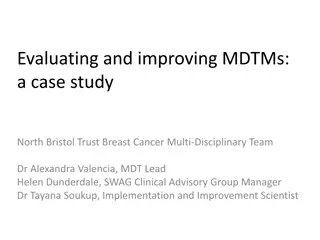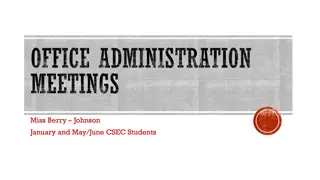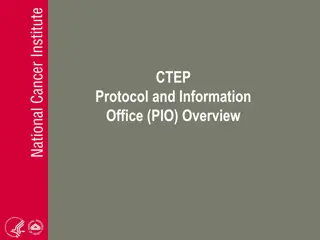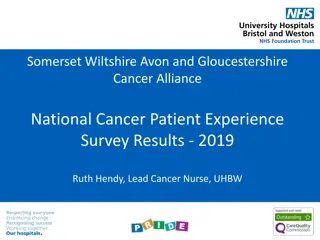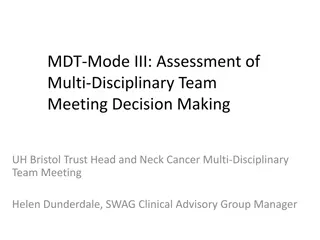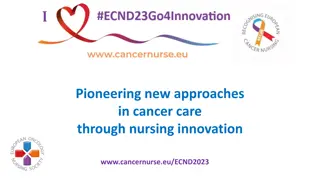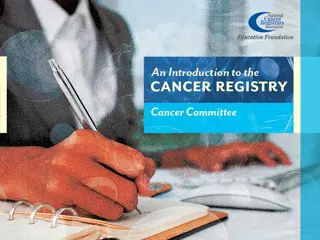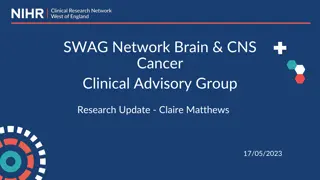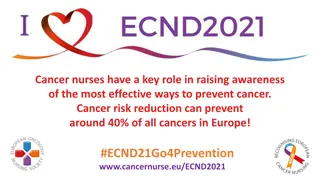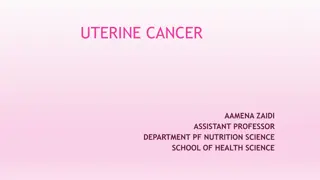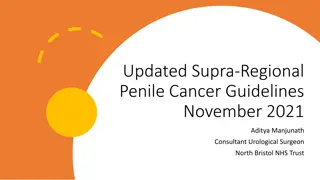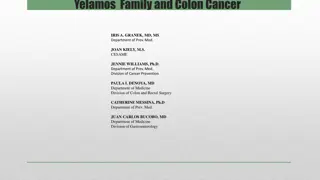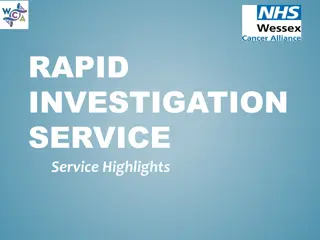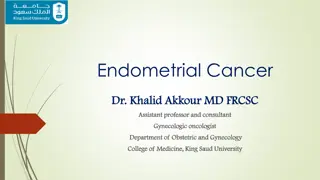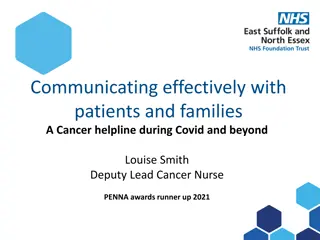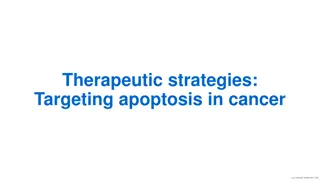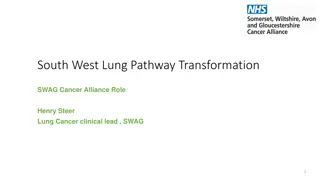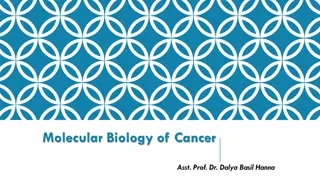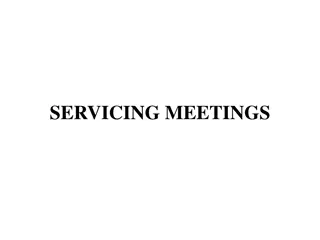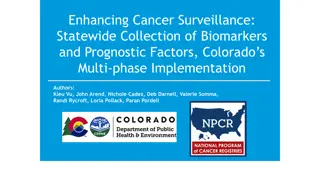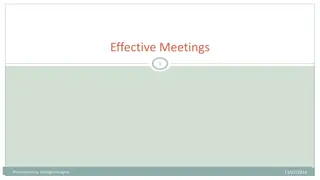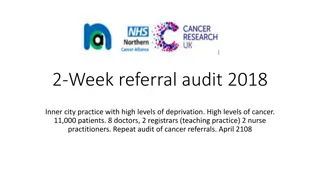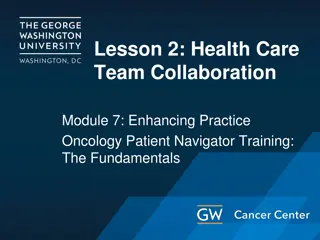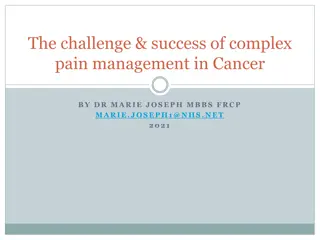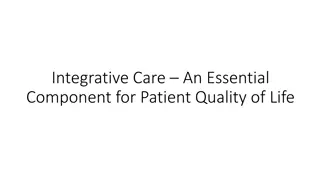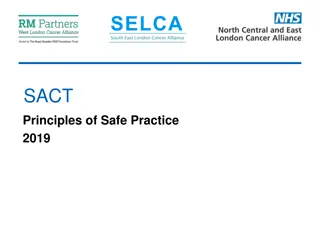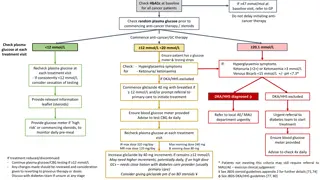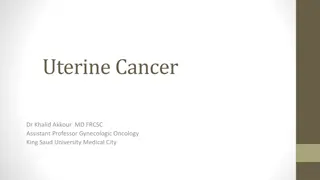Enhancing Multidisciplinary Team Meetings for Cancer Patient Management
Multidisciplinary Team (MDT) meetings are vital in cancer patient management, but challenges like increased patient volume and complexity require adaptation. Time pressures, the need for quality decision-making, and strategies like triage cases, standardized treatment pathways, and improving pathology review are discussed. Collaboration and training are essential for streamlining MDT processes and optimizing patient care outcomes.
Download Presentation

Please find below an Image/Link to download the presentation.
The content on the website is provided AS IS for your information and personal use only. It may not be sold, licensed, or shared on other websites without obtaining consent from the author. Download presentation by click this link. If you encounter any issues during the download, it is possible that the publisher has removed the file from their server.
E N D
Presentation Transcript
A good MDT MDT working is considered the gold standard for cancer patient management bringing continuity of care and reducing variation in access to treatment and ultimately improving outcomes for patients. The number of patients to be discussed in MDT meetings has grown significantly, as has the complexity of patients; due to an ageing population and the growing number of treatment options available. The way that MDT meetings are organised has not adapted to cope with this increased demand.
Quality and relevance of a MDT meeting within a multi-disciplinary team The quality of decision making has been shown to drop dramatically after discussion of 20 patient/after 1 hour Introduction of a 10 minute break in the MDT has been shown to bring balance to the quality of decision making and reduce the overall time of the meeting. Streamlining MDTs should work around the needs of radiology and pathology colleagues The key to streamlining is teamwork Teamwork in MDTs can be measured, assessed and improved, and there 3 validated tools that can be used for this purpose Training is required to use the tools to assess MDT performance.
Whats happening NHS England had a pilot period Locally Colorectal cancer Skin cancer Urology Sarcoma Pathology Common theme is Triage
How can we make the MDTM better? Triage cases Standardised treatment pathways Pre-MDT for clinicians Improve TAT for pathology will decrease chasing Realistic TATs In-line MDT review for pathology
Does pathology review add value? Introduction of double reporting all cancers Specialist reporting High proportion of cases the clinical information provided at MDTM does not change the diagnosis Why do we review?
R E P O R T Path A Reads slides MDT REVIEW Path B Double reports Audit pulls slides and prints report Path A,B or C Reviews slides and report Treatment can commence Treatment can commence MDT REVIEW R E P O R T Path A Reads slides Path A,B or C Reviews report ONLY Path B Double reports + checks report + adds line MDT review agrees Audit prints report ONLY
Draft Alliance guidelines implementation Develop and agree standards of care Agree an audit programme
Implementing streamlining All patients on a Cancer Alliance agreed predetermined Standard of Care must be listed at the full MDTM. No patient should be removed from oversight of the MDTM or responsibility of the MDTM. Patients listed not for discussion must have a completed minimum data set available (see section 7 below) which has been implemented as agreed by the tumour pathway board. If there are any queries on a patient or new information becomes available in advance of, at, or after the MDTM then the patient should be discussed at the MDTM; this could include physiological or psycho-social needs. Ability to refer the patient for discussion is a safeguard for patient care. Implementing streamlining may require changes to processes across clinical, administrative, and management roles. It is important to engage all staff to raise awareness and collaborate to help the work to embed effectively.
Minimum core data requirements: Minimum core data requirements: The following information must be accounted for in order to list a patient not for discussion at the MDTM: Diagnosis date (specify mode of diagnosis) Stage (specify investigations) Performance status Histopathological and/or cytological diagnosis; Co-morbidities; Availability of, and suitability for, clinical trial/s; Relevant genomic/genetic testing; Patient preference (if known) and/or any special circumstances have been taken into consideration MDTM recommendation and treatment pathway; Any additional tumour-specific tests needed to inform diagnosis
For a patient to be assigned for brief or no For a patient to be assigned for brief or no discussion at the MDT meeting discussion at the MDT meeting They have been seen by a core MDT member consultant or clinical nurse specialist (CNS) The minimum core data requirements have been met The pathology has been reported by designated persons for that tumour type Images have been reported by designated persons for that tumour type All other tests relevant to the decision-making have been completed (e.g. genomics) Patient preference stated (if known) and any special circumstances have been taken into consideration. Patients should be referred to the MDTM for discussion where preference contradicts a SoC pathway. The predetermined SoC has been reviewed by an appropriate person or triage group, there is clarity that it is appropriate, and all of the above have been fulfilled.
MDT efficiency and effectiveness project colorectal cancer Bristol The process is initiated by the referrer to the MDT The referrer completes the demographics and retains responsibility for actioning outcomes The referrer/endoscopist follows the pathway i.e. requests relevant initial investigations Therafter the radiology and pathology proformas trigger outcome by the MDT co-ordinator who books relevant appointments
Radiology 17
Pathology 07/04/2019 18
What has worked and not for us Effective team working yes/no Whole team buy in and ownership yes/no Uptake of radiology template reporting yes/no I like the way it is and see no reason to change I like concentrating on those cases that need discussion
What next To attempt to painlessly move the process forwards The SOC is the easy bit- you have it The challenge: How to make MDT meetings more effective but not increase bureaucracy and avoid a different triage process ie a second MDT I have agreement from the alliance to support job plan changes to facilitate this programme


